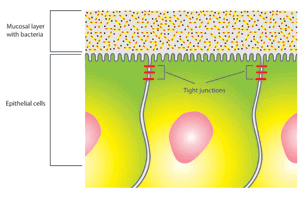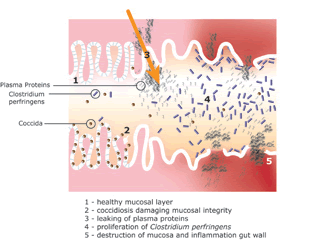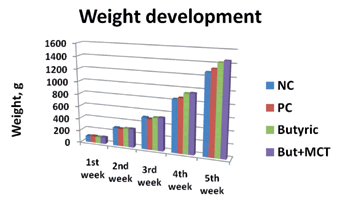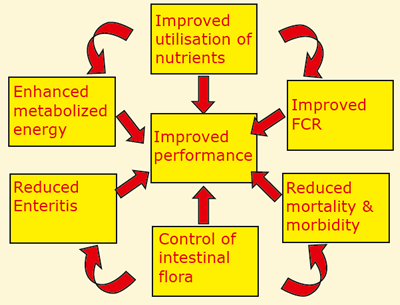
Biotronic® GutPower in poultry - innovation on the horizon
The main ingredients of Biotronic® GutPower are butyric, caprylic and capric acids in the protected glycerides form. The beneficial form of protection guarantees gastric by-pass and slow release of acids in the intestine where all acids become active. Butyric acid is a fuel for the enterocytes. It modifies gut structure by enlarging villi length and crypt depth which essentially improves nutrient absorption. Butyric acid increases enzymatic activity, enhances the reparation of gut wall lesions caused by intestinal diseases and nutritional imbalances and enhances barrier function of gut epithelium. Butyric, caprylic and capric acids act as antibacterials in the gut, especially caprylic and capric acids, are very strong antimicrobials at the higher pH value of the intestine. Moreover, triglycerides of caprylic and capric acids are easily absorbed from the gut, supplying the animal with an immediate boost of energy.A newly hatched chick increases its body weight by 25% overnight and by 5000% in a period of five weeks to 2 kg body weight. This astonishing performance of the modern chicken comes from:
- Intensive selection for growth rate
- Attention to health and management
- Advances in feed formulation
Perfect protection
The most beneficial protection is in the form of glycerides which is a chemical compound of acids and glycerol. The advantage of this protection is a high amount of active ingredients - about 78% (Figure 1).

Figure 1. Protection of acids in form of glycerides
The glycerol-acid compound is not influenced by the pH level or digestive enzymes of the stomach; therefore these compounds reach the small intestine where the gradual release of the acids through the action of lipases takes place.
MODE OF ACTION
Biotronic® GutPower increases absorptive surface of intestine
Butyric acid is an efficient nutrient for the intestinal mucosa increasing the density and length of villi and enlarging the absorptive surface of the intestine. Figure 2 shows the part of intestinal wall, villus and enterocytes.

Figure 1. Protection of acids in form of glycerides
The influence of butyric acid on changes of epithelial cell was investigated by Antoniogiovanni in 2006 (Table 1).
# Table 1. Influence of butyric acid glycerides on enterocytes
| Jejunum | Control |
Butyric acid glycerides |
Difference % |
| Microvillus, nm | 2.8a |
4.4b |
57% |
| Crypt depth, nm | 171a |
217b |
27% |
Butyric acid also influences the balance of cell formation (mitosis) and cell death (apoptosis), and as a result more epithelial cells are active in producing digestive enzymes and absorbing nutrients. When talking about cell regeneration, it has to be mentioned that the mucosal layer is completely regenerated within a few days. About 30% of nutritive energy is spent on the gut. By improving intestinal metabolism part of this energy can be saved for performance.
Better nutrient absorption also means better calcium utilization, which is especially important for egg shell quality. Percentage of cracked and broken eggs was reduced significantly by including butyrate in the diets of layers in the research carried out by Schwartzer (2006). Similar results for breeders (Table 2) were delivered by Sengor et al (2007).
Table 2. Egg characteristics of 1600 breeder hens receiving butyric acid.
| Egg Characteristics | Control |
Butyric acid |
| Eggshell strength (kg/cm2) | 1.76 | 2.07 |
| Crack egg (%) | 3.44 | 2.21 |
| Misshapen egg (%) | 6.27 | 3.81 |
| Hatching egg (%) | 88.93 | 93.36 |
Biotronic® GutPower enhances the barrier function of the gut
Enhancing gut barrier function is also one part of the mode of action of butyric acid. Butyrate upregulates the expression of tight junction proteins making the penetration of Salmonella and other bacteria through the epithelial layer difficult and avoiding the invasion of bacteria in the blood (Figure 3). The complementary action of the acids in Biotronic® GutPower is on the one hand keeping the pathogens in the intestinal lumen and on the other hand reducing the amount of pathogens in the gut.

Figure 3. Tight junctions in the intestine
Biotronic® GutPower acts as an antimicrobial via different strategies Butyric, caprylic and capric acids are also known as antibacterial agents against pathogenic microorganisms, including Salmonella, Clostridia, Escherichia coli, Campylobacter. In particular, caprylic and capric acids are strong antimicrobials at higher intestinal pH value. Antibacterial activity of medium chain fatty acids (capric, caprylic) is higher than short chain fatty acids (formic, acetic, propionic, butyric) against gram positive and gram negative bacteria (Nakai et al., 2002). Medium chain fatty acids have a synergistic ability to suppress the expression of the genes required for invasion and to reduce the number of bacteria in vivo (Immerseel et al., 2004). Caprylic, capric and butyric acids down regulate the pathogenicity gen of Salmonella by decreasing the expression of hil A gene, a key regulator related to the invasion capacity of Salmonella in intestinal epithelial cells (Gantois et al., 2006; Immerseel et al., 2004).
Medium Chain Triglycerides - immediate boost of energy
Caprylic and capric acids are the main constituents of medium chain triglycerides (MCT). MCT can diffuse through the enterocytes wall without the assistance of carriers, which supplies the animal with fast available energy (Figure 4).

Figure 4. MCT and LCT penetrating epithelium.
Scientific trial
About 80% of broilers carry Clostridium perfingens in the gut and a small number develop necrotic enteritis, depending on predisposing factors. Therefore it is especially important to strengthen the gut and reduce the damage of mucosa by coccidia and clostridia. Coccidiosis cause mucosal damage, which decreases digestibility and initiates the release of plasma proteins into the gut lumen. Plasma proteins are used as a growth substrate for Clostridium perfringens and it leads to necrotic enteritis as shown in Figure 5.
The influence of glycerides of butyric, caprylic and capric acids on growth performance of broiler chickens was described by Antongiovanni et al. (2005) by means of a challenge trial (Necrotic enteritis model) with Clostridium perfringens 5x105 CFU (Colony Forming Unit) and Eimeria acervulina 103 oocysts. The application dosage of butyric acid glycerides and glycerides of caprylic and capric acids was 2 kg/ton feed and 1.5 kg/t feed respectively. The application period of glycerides was 21 days.10 ppm avilamycin was used as a positive control group for the whole trial period.
The summarised results of the trial are shown in Table 3 and Figure 4.
The outbreak of necrotic enteritis in all groups was visible after the infection at the third week but birds fed with glycerides had better performance than the negative and positive control groups. The improvement of final body weight (BW), average daily weight gain (ADWG) and feed conversion rate (FCR) of the group fed with glycerides of butyric acid and glycerides of butyric, caprylic and capric acids was around 11% and 14% respectively, compared to the negative control group (NC). Figure 6 shows the weight development of broilers for the trial period.

Figure 5. The damage of intestinal mucosa by Eimeria and Clostridia.
Table 3. Effect of butyric, caprylic and capric acids on growth performance in poultry
Control NC |
Avilamycin PC |
Butyric acid glycerides |
Glycerides of butyric, caprylic and capric acids |
|
| Application | - |
35 days |
21 days |
21 days |
| Weight d 35, g | 1278a |
1332a |
1426b |
1457b (+14%) |
| DWG, g | 29.52a |
30.80a |
33.04b |
33.78b (+14%) |
| FCR | 2.14ac |
2.29a |
1.91bc |
1.86c (-13%) |
The increased resistance of chickens in the groups containing glycerides of butyric, caprylic and capric acids to the infection is due to:
- Better gut and mucosa development.
- Increased capacity of repairing pathogen lesions.
- Microflora control

Figure 6. Effect of butyric, caprylic and capric acids on weight development in poultry
Conclusion
Optimizing gut health is key to improving animal performance. Biotronic® GutPower assures gastric by-pass and release of acids in the intestine. This leads to an enlarged intestinal surface and improved nutrient absorption. Butyric, caprylic and capric acids protect the animal from pathogens through active action against microorganisms and upgrading of physical barrier function of intestinal wall. The innovative product, Biotronic® GutPower, is a tool for optimizing animal performance.

Benefits of Biotronic® GutPower
For Further Product Information Please Visit www.biomin.net
Featured Products

Biotronic®
Naturally ahead in dynamic acidification!
Related Articles

Biotronic®
Efficiency of Biotronic® Product Line in Poultry

Biotronic®
Ascites in poultry

Biotronic® Top3
Biotronic Top3 to Capitalise on Perforizer Effect
Related Services

Mycotoxin Channel
World renowned experts answer mycotxin related questions.

Mycotoxins.info
A wealth of Mycotoxin information at your fingertips

World Nutrition Forum
The future of animal nutrition






